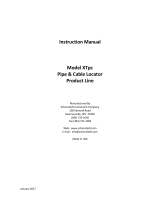
3
Table of Contents
Section 1 The Basics of Cable Locating
1. Introduction ........................................................................................................................... 7
2. Applying the Signal: The Direct Connect Method ................................................................. 8
3. Applying the Signal: The Induction Method ......................................................................... 9
4. Applying the Signal: The Dyna-Coupler Method................................................................. 10
5. Other Locating Signal Sources ........................................................................................... 10
A. Passive Signals ............................................................................................................. 10
B. Power Frequencies ........................................................................................................11
C. Radio signals..................................................................................................................11
D. Cable TV Signals............................................................................................................11
E. Other Transmitted Signal Sources .................................................................................11
6. Choosing Trace Modes....................................................................................................... 12
7. One Touch Gain adjustment ............................................................................................... 13
8. Locating Techniques ...........................................................................................................14
A. Sweeping....................................................................................................................... 14
B. Positioning..................................................................................................................... 14
C. Tracing........................................................................................................................... 14
D. Identifying Cable By Depth-Current Measurement........................................................ 15
E. Tracing Currents............................................................................................................ 16
9. External DC Power and 5 Watt Output ............................................................................... 17
A. External DC Power........................................................................................................ 17
B. 5 Watt Output ................................................................................................................ 17
Section 2 Telephone Cable Locating Techniques
1. Introduction ........................................................................................................................... 9
2. Applying Signal to Telephone Cable: Induction Method ....................................................... 9
3. Applying Signal to Telephone Cable: Direct-connect Method ............................................. 20
4. Applying Signal to Telephone Cable: Dyna-Coupler Method .............................................. 21
5. Locating Slack Loops and Butt Splices............................................................................... 23
6. Locating Unknown Laterals ................................................................................................ 23
7. Locating Cables from Pedestals ......................................................................................... 24
8. Locating Service Drops....................................................................................................... 25
9. Locating an Open End ........................................................................................................ 25
10. Identifying Cables.............................................................................................................. 25
11. Pair Identification ............................................................................................................... 26
12. Locating Splits ................................................................................................................... 27
13. Fiber Optic Locating .......................................................................................................... 28
A. Can the Fiber Be Traced? ............................................................................................. 28
B. Applying the Trace Signal.............................................................................................. 29
Attaching at CO or Remote Terminal Office .................................................................. 29
Attaching at the Splice Point ......................................................................................... 29
C. Tracing the Fiber Optic Cable........................................................................................ 30
Section 3 Power Cable Locating Techniques
1. Introduction ......................................................................................................................... 31
2. Applying Signal to Power Cables: Direct-connect Method ................................................. 31
A. Applying Signal to the Transformer ............................................................................... 31
B. Applying Signal at the Meter ......................................................................................... 31
C. Applying Signal to De-Energized Secondaries.............................................................. 32
3. Applying Signal to Power Cables: Induction Method .......................................................... 32




















